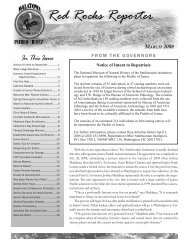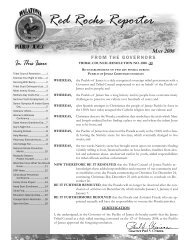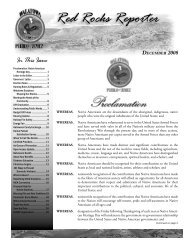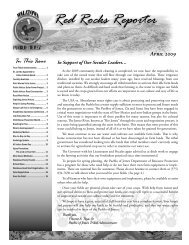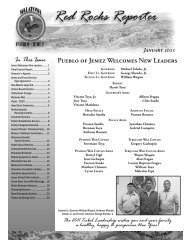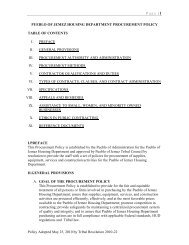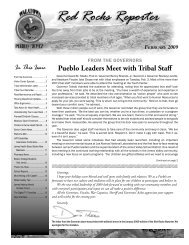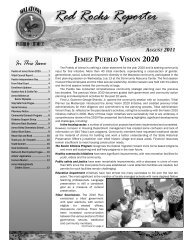Create successful ePaper yourself
Turn your PDF publications into a flip-book with our unique Google optimized e-Paper software.
Page 8 <strong>March</strong> <strong>2012</strong> <strong>Pueblo</strong> <strong>of</strong> <strong>Jemez</strong> Red Rocks Reporter<br />
PUBLIC HEALTH<br />
FITT 4 Life 12-Week Fitness Challenge<br />
JHHS Public Health Programs and Community Wellness Program are sponsoring<br />
FITT 4 Life, a 12-week fitness challenge designed to help community members<br />
adopt healthier lifestyles. The long-term program focuses on measurable goals that<br />
demonstrate improved health and fitness over time.<br />
There are more than 200 participants in the FITT 4 Life challenge. Four-person<br />
teams serve as support networks, but fitness and nutrition goals are individualized for<br />
each participant. Teams win incentives based on completing Healthy Lifestyle cards<br />
with specified milestone activities. Fitness coaches are available to answer questions<br />
and <strong>of</strong>fer advice and encouragement.<br />
Comprehensive assessments allow each participant to measure individual<br />
improvement. Assessments include body-fat analysis; blood sugar, blood pressure and<br />
cholesterol; weight, chest, hip, waist and thigh measurements; and performance on<br />
physical tests such as push-ups and sit-ups. Behavioral goals track physical activities<br />
and nutrition and cooking classes. Participants have a wide range <strong>of</strong> options for meeting<br />
their goals, including circuit training, aerobics classes, Zumba, basketball, volleyball,<br />
cycle core, plyometrics, agility exercises, twice-daily 15-minute walks starting<br />
at the Health Center; and bike, running and walking groups at noon at the Health<br />
Center. Twenty bikes are available to borrow for rides at 10 a.m., noon, 3 p.m. and 5<br />
p.m.; one-hour evening bike rides are scheduled Mondays, Wednesdays and Sundays.<br />
For more information, contact the Public Healt h Programs at (575) 834-7207.<br />
The Impact <strong>of</strong> Obesity and Diabetes In <strong>Jemez</strong><br />
COMMUNITY WELLNESS<br />
PRE-ASSESSMENT RESULTS:<br />
THE “AVERAGE” PARTICIPANT<br />
“These numbers are averages <strong>of</strong> all the<br />
pre-assessment results,” explains Kristyn<br />
Yepa. “If we were all one person, our preassessment<br />
would look like this:<br />
ASSESSMENT<br />
RESULT<br />
Height 5’ 3’’<br />
Weight<br />
184 lbs.<br />
Age<br />
36 years<br />
BP 120/78<br />
Total Cholesterol 192<br />
Triglycerides 200<br />
HDL 47<br />
LDL 105<br />
Blood Sugar 108<br />
Chest (inches) 41<br />
Waist (inches) 40<br />
Hip (inches) 42<br />
Thigh (inches) 20<br />
Sit-n-Reach 12<br />
Push-ups 27<br />
Sit-Ups 15<br />
12-min test 19<br />
Studies prove a strong link between being overweight or obese<br />
and the risk <strong>of</strong> developing diabetes. Type 2 diabetes does not<br />
happen overnight – it can take 10 years to develop. People spend<br />
these ten years NOT making the diet and lifestyle changes that can<br />
help delay or even prevent developing the disease.<br />
Know the Risk Factors<br />
Certain factors increase the risk <strong>of</strong> developing Type 2 diabetes:<br />
► American Indian/Alaska Native<br />
► A family history <strong>of</strong> type 2 diabetes<br />
► Over the age <strong>of</strong> 45<br />
► Had gestational diabetes or had a baby weighing 9 pounds or<br />
more at birth.<br />
► Low HDL levels, high triglycerides, high blood pressure<br />
► Overweight/obese<br />
► Not enough regular exercise<br />
Obviously ethnicity, family history and age are risk factors we<br />
can't control. However, being overweight or obese and not getting<br />
enough exercise are risk factors we can change.<br />
Native Americans and Diabetes<br />
At nearly 16.1 percent, American Indians and Alaska Natives<br />
have the highest age-adjusted prevalence <strong>of</strong> diabetes among all<br />
U.S. racial and ethnic groups. The prevalence <strong>of</strong> Type 2 diabetes<br />
in Native American communities has increased dramatically in the<br />
past 50 years. IHS <strong>of</strong>fers these frightening statistics:<br />
► Likelihood <strong>of</strong> American Indians/Alaska Natives (AI/AN) to have<br />
diabetes compared with non-Hispanic whites: 2.2 times higher.<br />
► Increase in diabetes from 1994 to 2004 in AI/AN youth aged<br />
15-19 years: 68%<br />
► Estimated percent <strong>of</strong> AI/ANs who have pre-diabetes: 30%<br />
Although it's not known if Native Americans have a genetic<br />
predisposition for developing diabetes, it is clear that diabetes is<br />
directly related to poor diet choices that lead to being overweight<br />
or obese. Many factors contribute to this marked increase, but<br />
studies indicate that a trend away from traditional lifestyles in favor<br />
<strong>of</strong> westernization, with accompanying increases in body weight and<br />
diminished physical activity, is largely to blame.<br />
Research suggests as indigenous people become more<br />
westernized or acculturated, their health gets worse. Our bodies<br />
have not adjusted well to eating processed foods like SPAM ® ,<br />
Jell-O ® , marshmallows, Cool-Whip ® , soda, chips, candy bars and<br />
foods that were made in test tubes.<br />
Elizabeth Gaines-Gray (Cherokee/Shawnee) founded the<br />
Native American Times, the largest independently-owned Indian<br />
newspaper in America. She has launched American Indian &<br />
Minority Health, Inc. to focus on diabetes among Native Americans.<br />
“Traditional foods are more healthy than westernized refi ned<br />
carbohydrates,” she says. “Indian people had wisdom in what they<br />
ate.” The biggest problem, she adds, is "junk food." “Those foods<br />
are totally stripped <strong>of</strong> nutrients, but they're cheap and easy to get.”<br />
Continued on page 12



